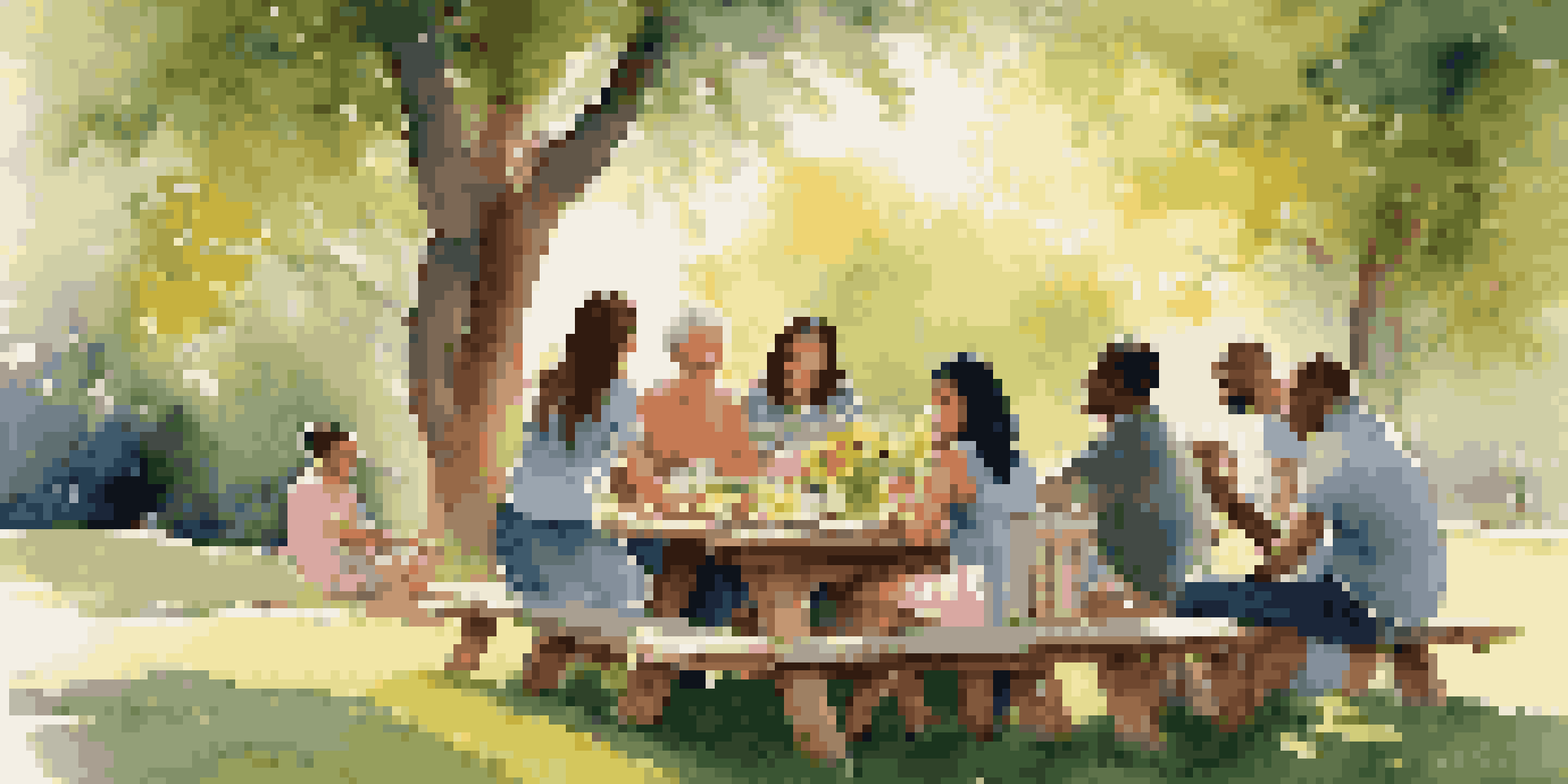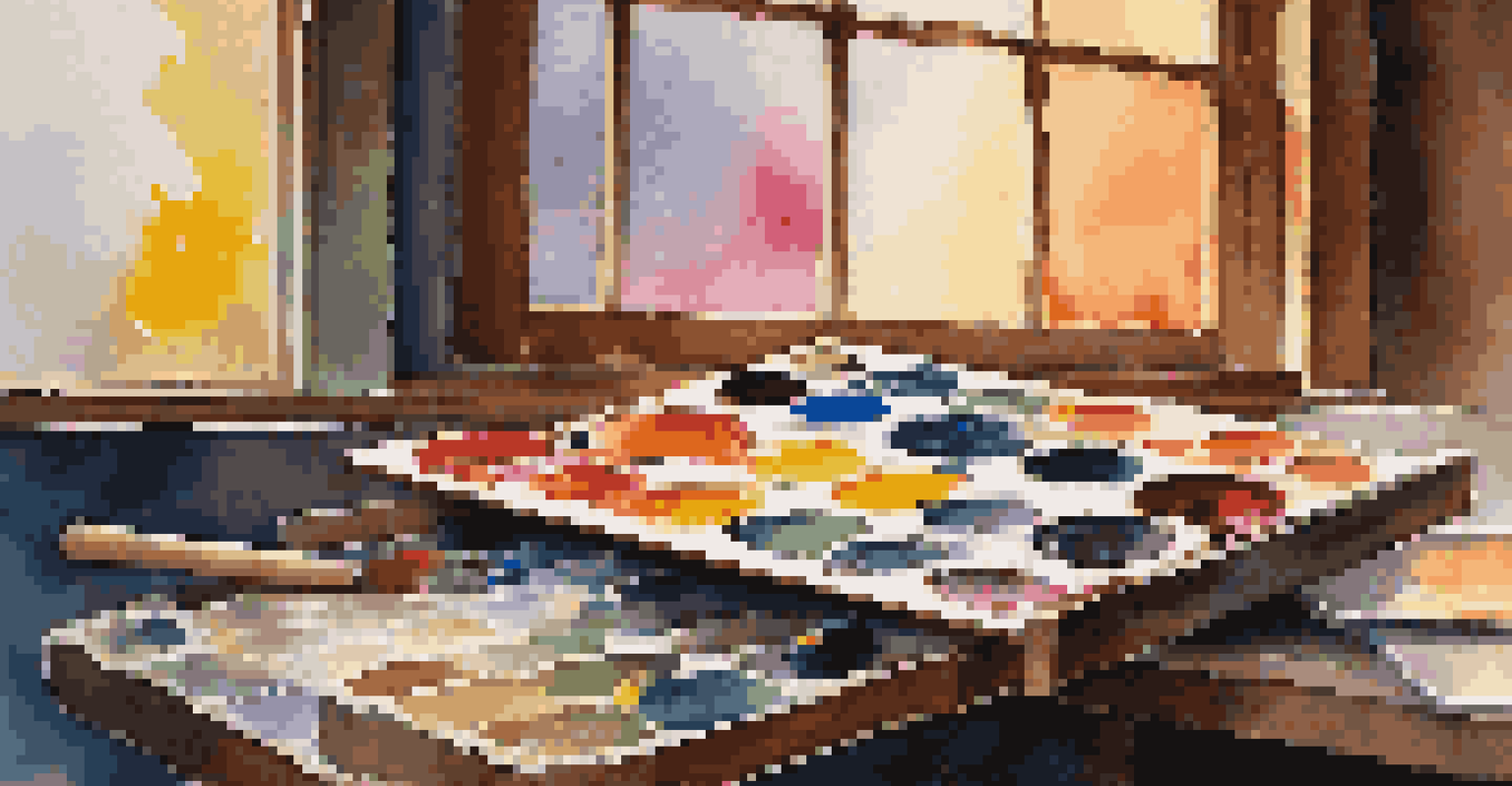The Power of Narrative in Art: Identity through Storytelling

Understanding Narrative and Its Role in Art
Narrative in art refers to the way stories are conveyed through visual means. It can be expressed through paintings, sculptures, and even installations, where each piece tells a unique tale. This storytelling aspect engages viewers, inviting them to interpret and connect with the artwork on a personal level. Ultimately, narrative enriches the viewer's experience and adds layers of meaning to the artistic expression.
Art is the most beautiful of all lies.
For example, think of a painting depicting a family gathering. The expressions, the setting, and the interactions all hint at deeper stories about relationships and history. Each viewer may find different interpretations based on their own experiences, making the artwork resonate on multiple levels. This is the beauty of narrative in art—it creates a dialogue between the artist and the audience.
Moreover, narratives can be universal or deeply personal. They can reflect collective experiences, such as cultural traditions, or intimate moments from an artist's life. This duality allows art to be both a mirror of society and a window into individual identity, emphasizing the power of storytelling in shaping our understanding of ourselves and others.
Identity Through Storytelling in Visual Arts
Art serves as a powerful vehicle for exploring and expressing identity. Through storytelling, artists can convey their backgrounds, cultures, and personal journeys, allowing viewers to engage with diverse perspectives. For instance, an artist from a marginalized community may use their work to highlight social issues, thereby telling stories that might otherwise go unheard.

Consider the works of Frida Kahlo, whose self-portraits are rich with personal narrative. Each brushstroke reveals her struggles, triumphs, and cultural identity, inviting viewers to delve into her world. Kahlo’s art provides a profound commentary on gender, class, and post-colonialism, showcasing how narrative can be woven into the fabric of identity.
Art Tells Unique Stories
Narrative in art enhances viewer engagement by inviting personal interpretations and connections through visual storytelling.
This interplay between identity and storytelling not only enriches the artwork but also fosters empathy among viewers. As people engage with narratives from different backgrounds, they gain insights into experiences that may differ vastly from their own, ultimately broadening their understanding of humanity.
The Influence of Cultural Narratives in Art
Cultural narratives play a significant role in shaping artistic expression. Artists often draw from their heritage, traditions, and historical contexts to create works that reflect their cultural identities. This can be seen in various art forms, from indigenous crafts to contemporary installations that tackle issues of cultural representation and appropriation.
Every artist dips his brush in his own soul, and paints his own nature into his pictures.
For example, the vibrant murals of Mexican artist Diego Rivera tell stories of social struggle and the rich history of Mexico. His work not only preserves cultural narratives but also educates viewers about the complexities of identity shaped by history. Rivera’s murals serve as a reminder of how art can be a powerful tool for cultural preservation and social commentary.
By incorporating cultural narratives, artists create connections between the past and present, allowing viewers to appreciate the richness of diverse identities. This celebration of cultural storytelling enhances the depth of art, making it a vital means of communication in a global society.
Personal Narratives: The Artist's Voice
Personal narratives are often at the heart of an artist's work, showcasing their unique experiences and viewpoints. When artists share their stories, they invite viewers to understand their emotions, struggles, and triumphs, fostering a sense of intimacy and connection. This personal touch can transform a simple artwork into a profound experience.
Take the example of Vincent van Gogh, whose letters reveal the turbulent emotions behind his masterpieces. His paintings, infused with personal narrative, evoke feelings of isolation and passion that resonate deeply with viewers. Each brushstroke becomes a testament to his life's narrative, illustrating how intimately intertwined art and personal story can be.
Identity is Expressed Through Art
Artists convey their backgrounds and experiences through personal narratives, fostering empathy and understanding among diverse audiences.
By expressing personal narratives, artists not only validate their own experiences but also encourage others to reflect on their identities. This powerful exchange can inspire viewers to explore their own stories, creating a shared space for understanding and healing through art.
The Role of Audience Interpretation in Narrative Art
Audience interpretation plays a crucial role in the narrative aspect of art. Every viewer brings their own experiences, emotions, and perspectives, which influences how they engage with a piece. This dynamic interaction can lead to a multitude of interpretations, making the artwork a living entity that evolves with each observer.
For instance, a minimalist sculpture may evoke feelings of calm in one viewer while prompting existential questions in another. This variability underscores the power of narrative in art: it becomes a vehicle for dialogue, allowing audiences to explore their identities through the lens of the artist's story. The richness of narrative art lies in its ability to resonate differently with each individual.
As viewers interpret narratives in art, they often find connections to their own lives, allowing for personal reflection and growth. This shared experience not only enhances the appreciation of the artwork but also fosters a sense of community among those who engage with it, emphasizing the collective power of storytelling.
Art as a Tool for Social Change and Identity
Art has long been recognized as a powerful tool for social change, and when combined with narrative, its impact can be profound. Artists often use storytelling to shed light on social issues, challenge stereotypes, and advocate for justice. Through their work, they can inspire action and provoke thought, making art a catalyst for change.
Consider the street art of Banksy, which often carries strong political messages. Each piece tells a story that critiques societal norms, encouraging viewers to question the status quo. By weaving narratives into their art, these artists not only express their identities but also invite others to engage in conversations about pressing social issues.
Art Drives Social Change
By incorporating narrative, artists can address social issues and inspire dialogue, making art a powerful tool for advocating justice.
This intersection of art, narrative, and social change underscores the significance of storytelling in shaping collective identity. As artists share their perspectives, they empower communities to find their voices and advocate for their rights, illustrating how narrative art can drive positive transformation.
The Future of Narrative in Art: Emerging Trends
As we look to the future, narrative in art continues to evolve, influenced by technological advancements and shifting cultural dynamics. Digital art, for example, opens up new avenues for storytelling, allowing artists to explore interactive and immersive experiences. This innovation invites viewers to become active participants in the narrative, further deepening their engagement.
Moreover, the rise of social media platforms has democratized art, enabling diverse voices to share their stories with a global audience. Artists can now reach broader communities, sparking dialogues that transcend geographical boundaries. This interconnectedness enhances the richness of narrative art, weaving a tapestry of experiences from around the world.

As we embrace these emerging trends, the power of narrative in art will continue to play a pivotal role in shaping identity and fostering connections. By harnessing the potential of new mediums and platforms, artists can inspire future generations to tell their stories, ensuring that the art of storytelling remains vibrant and vital.